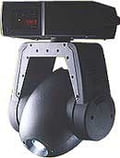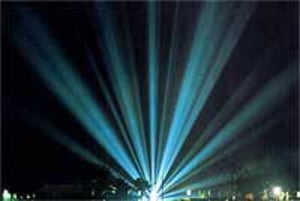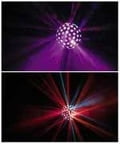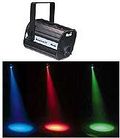3. Lighting Effect Types
Basic Lighting Effects
Beam Effects are fixtures that are comprised of many different coloured lenses positioned around a central light source, with each lens projecting a single beam of light. They normally come in the form of a half sphere (known as a mushroom), or as one or more complete spheres spinning with the aid of motors around the encapsulated lamp. This movement is often continuous, but some beam effects can vary the direction of the spin based on sound received by their built-in microphones, for example changing direction with each kick-drum beat. When used in conjunction with stage fog, coloured beams are extremely effective, and larger fixtures with more powerful lamps can provide good coverage even in bigger venues.

Flower Effects are stand-alone fixtures with adjustable attributes such as beam colour, gobo type, rotation and lamp all controlled automatically by the built-in microphone. Some models features switches at the rear which select whether an attribute is either triggered by a specific frequency, continually rotates, or remains static. Flower effects do not usually allow external control over their attributes, so you are limited to simply turning them on or off. This lack of control makes them less suitable for larger venues, but their ease of installation and simplicity make them very attractive for smaller Locations.

Centrepieces As the name suggests, these effects are designed to be located at the centre of a lighting rig, usually directly above a dance-floor, and they tend to work well alongside flower effects. Their construction is based on a central lamp surrounded by several mirrors which reflect light in all directions. Centrepieces are available with various mirror types, and this can change the appearance of the effect considerably. Fixed offset rotation mirrors move the beams in circles but offer no control over direction, while pan and tilt mirrors have full control over the direction of the beam across both axis, and barrel mirrors produce a continually falling beam. Like the flower, control of the colour and gobo type in each beam is normally synced to audio, along with its direction, and is not externally controllable by the user. However, some more sophisticated centrepieces offer full DMX control over all functions independently.

Barrel Mirror Effects Strongly resembling scanners, barrel mirror effects replace a fully controllable mirror with a permanently rotating barrel mirror to create a continually falling beam. These effects, just like flowers and centrepieces have lamp colour, gobo type and mirror direction functions synchronised to the built-in microphone.
Professionell Lighting Effects:
Colour Changers We now move towards the higher end of effects lighting. The colour changer is a fixture which offers DMX control over beam colour. Inside the fixture, one or more colour wheels containing different coloured filters rotate in the path of the beam. Some fixtures have more than one wheel which allows colours to be mixed by placing two different filters in the beam - the more colour wheels a fixture has, the more individual colours it can produce. Very often these effects have a stand-alone mode in addition to DMX control.

Scanners incorporate a user-controllable mirror which gives access to its pan and tilt, allowing the beam to be positioned in any direction within the range of the fixture, typically around 230° pan and 75° tilt. As well as control of the mirror, some models offer DMX control of colour, gobo, shutter and even focus. With full control over all these parameters, sophisticated effects can be created - the downside however is that many scanners dont have a stand-alone mode, and therefore a lighting controller is a prerequisite. As with moving head effects (see below), there is a big difference in quality across the range, both in the feature sets available, and in the accuracy of the motors controlling the gobo, shutter, colour selector, and in particular the mirror, which can suffer from beam stutter. This is where the resolution of the stepper motors controlling the mirror movement is so low that it makes the beam jerk - something thats especially noticeable with slow movements.

Moving Heads have all the functionality of scanners, but instead of reflecting the beam of light off a moving mirror, the whole fixture moves, allowing for a greater range of pan and tilt - typically up to 540° pan and 260° tilt. This movement is generally slower than that of a scanner as the motors have to shift the weight of the entire fixture rather than just the mirror. As with scanners, colour, gobo, shutter, focus and movement must be controlled by a central system via DMX. The low gearing of motors characteristic of moving heads allows for much smother, slower moves than scanners offer, and the quality of the motors is less important. Pay particular attention though to both the quality of the optics, and the number of different colours and gobos provided - youll find that more expensive moving head effects incorporate rotating gobos, a rotating prism and a number of different colour wheels giving the user full control over all the lights parameters, and allowing for complex effects and sequences to be programmed. All the parameters must be programmed into a controller before a moving head can be used though, and for this reason they are not as easy for the inexperienced user to rig as some of the other effects lights discussed here.
Gobo Projectors are lighting fixtures designed solely for the projection of shapes onto large surfaces using gobos and high quality optics. The fixture can sometimes change the beam colour, but a more common feature is a gobo rotator, which allows for more dynamic projection effects. One example of their use is for the projection of corporate logos onto large surfaces logos, or any other shape for that matter, can be recreated in monochrome by using a metal gobo, or more professionally in full colour with a glass gobo.


Sky Trackers As the name suggests, a sky tracker is an outdoor effect used to light up the sky, and is normally used as a visual marker to attract visitors to an event. The extremely bright light source, usually upwards of 5000w, is tightly focused and often visible from many miles away. Some trackers incorporate a singe light beam, but more commonly these days their output is split into many smaller beams by using a multi-faced moving mirror. Although expensive to buy and large in size, rental of a unit for an evening can add another dimension to your Event.










